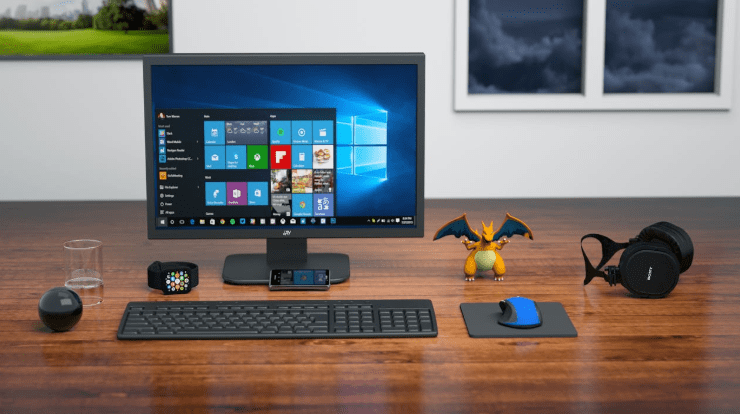Are you experiencing problems with PC-attached peripherals, such as your mouse, keyboard, webcam, or another accessory? Whether you’re using legacy or USB peripherals, problems could arise at some point. In some cases, peripherals stop working following an update. The good news is that fixing these common problems with PC peripherals is often simple. A shortcut is to use the Windows troubleshooter. The interface may vary from one Windows operating system to another, but the purpose is the same.
Click the Start button, open the Hardware and Devices troubleshooter, and then select Troubleshooting. This will automatically check your computer for any problems with hardware and other devices.
Common PC Peripheral Problems and How to Solve Them
The first step is to always check the hardware. The cables may be damaged or the USB hub you’re using between your PC and the peripheral may not have power.
#1: Problems with a port
If the attached peripherals suddenly stop working, check the Device Manager to see if the port itself is to blame. A red exclamation mark (!) means there’s an error with the port.
Delete a device from the Device Manager and then reboot your computer. Once your PC is up and running again, install the device driver.
#2: Problems with the port connectors
Especially with PS/2 ports, one or two of those holes could be clogged with dust, causing a loss in connection with the pins. The same thing could happen when the pins on the peripheral connector are damaged.
A USB port can get damaged, too, resulting in no power or connection. A solution would be to use another USB port.
#3: USB standards don’t match
Newer USB devices may not run on old USB ports. Most of them would need a 3.0 cable for high-speed processing. If the USB port and device are incompatible, attached peripherals will not work.
#4: Error with wireless keyboard or mouse

Wireless peripherals often rely on the IR or RF controller to work and communicate with a computer. If it doesn’t work the first time you use it, you could be using an old operating system. Most wireless PC peripherals need a newer OS Service Pack. So, if you’re still using Windows 95 OS or older, an upgrade will fix the problem.
If you’re using the current operating system and the wireless keyboard and mouse still don’t work, the problem may be an interference with the line of sight or a weak battery. Use the peripherals on other PCs to help identify the cause of error.
If the wireless device has a reset button, use it to reset the device and refresh the connection. It would also help if you unplug the USB wireless receiver and leave it off for about 10 seconds. This will help reestablish the wireless connection once you plug the receiver back into the port.
#5: PS/2 keyboard and mouse not working
See that the device is plugged in the correct port. If the port and cable are color-coded, the keyboard cable should go into the purple-colored port and the mouse into the green-colored port.
Color coding can vary. Try to switch them up and see if doing so helps fix the problem. Follow the same process if the PS/2 connectors are identical in color and you need to identify which one is designated for the keyboard and the mouse.
If the cables are on the right parts and the peripherals still don’t work, try to use other devices. The keyboard or mouse may need replacement.
#6: Blocked keys or sensors
Dirt blocking the keys or sensors prevents PC peripherals from responding to commands. Regardless of how much you click on a mouse or press a key, nothing will happen if contact is not established.
#7: Input devices stop working after updates
Following an operating system or software update, one or two of your attached PC referrals may no longer work. There are several ways to restore a device’s functionality.
Switch USB ports
Doing so will force your computer to recognize a device. A computer system usually recognizes a device based on their location or the specific USB port where the device was attached before any updates were made. If the system thinks nothing has changed, it will not reload drivers, resulting in peripherals not working. Thus, the need to switch USB ports.
Start in safe mode
In some cases, a driver in the cache will not load properly after an update. The result is a broken mouse and keyboard … or so it might appear. With a bit of a system purge in safe mode, the boot will reload drivers and load them properly.
Reset the PRAM
During a firmware update, the PRAM settings of your computer, which include peripheral devices, video settings, startup disk, and audio volumes, may be reconfigured. Reset the PRAM to fix the problem.
Reboot the system and then press and hold down the option-command-P-R keys at the same time. Wait for your computer to reset and chime a couple of times at reboot before you release the keys.
Power cycle the entire system
Faulty settings may occur after an update. Remove a peripheral device from your computer and leave it off for a few minutes. For better results, shut down your computer as well and power cycle it. After 5 to 10 minutes, turn the computer back on and then plug the attached peripherals back in.
#8: Mouse and keyboard stopped working when the printer is turned on
Ensure efficient power
This could happen when the USB ports for the keyboard and mouse receive too little power to work because the printer is hogging all of it. Make sure not to connect the printer to a USB hub that is shared by the keyboard and mouse.
Another solution is to plug the devices into different USB ports. Attached peripherals can go at the back of the computer while the printer is plugged in at the front.
Fix interference
Do your keyboard, mouse, and printer all use a wireless connection? They could be interfering with one another, even if one is using radio frequency while the other relies on Bluetooth.
To avoid conflict and establish different frequencies for different devices, switch off the keyboard and mouse. When you switch them back on, they will be forced to reconnect to your computer using a free frequency.
Check driver compatibility
Conflicts between drivers could cause problems with different devices. Communication with your operating system will be effected and will result in devices not working properly. Open Device Manager and check that drivers for peripherals and the printers are updated.
Double click on a device and open the Properties windows. Under Driver tab, check if the option to Update Driver is available. This means a newer version of a driver is available.
Reinstall devices
If you’ve done all the steps above and the problem persists, you may need to reinstall devices to resolve the issue.
- Remove the PC-attached peripherals from Device Manager.
- Any related software must be uninstalled from your computer.
- Restart the system.
- Switch on the printer and see that it is connected to your computer and working properly.
- Reconnect the keyboard and mouse like you’re using them for the first time. This reinstalls the peripherals and ensures there are no conflicts.
If you’re still having issues with these common problems with PC peripherals, check out our guide on how to reset your Windows 10 computer here.


